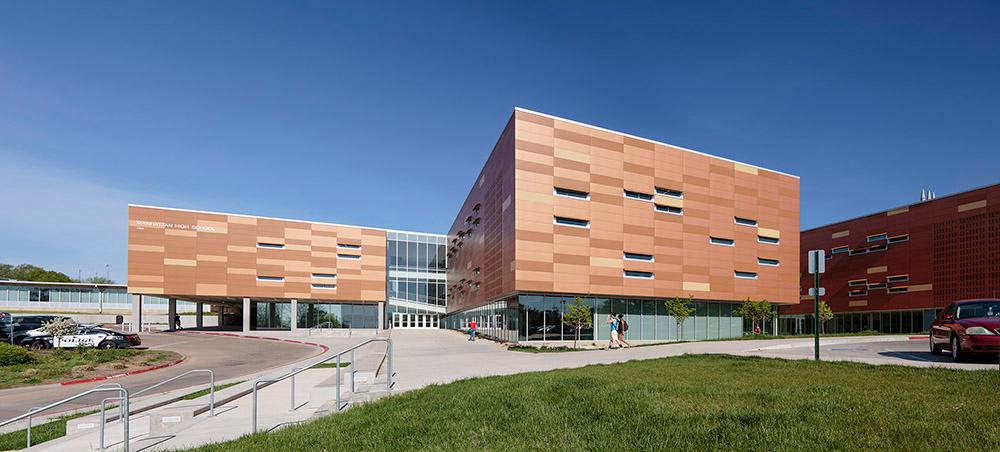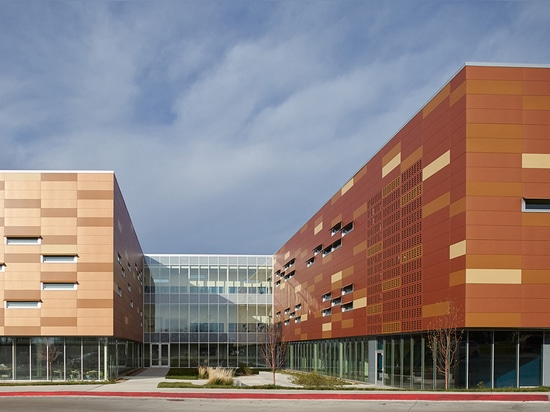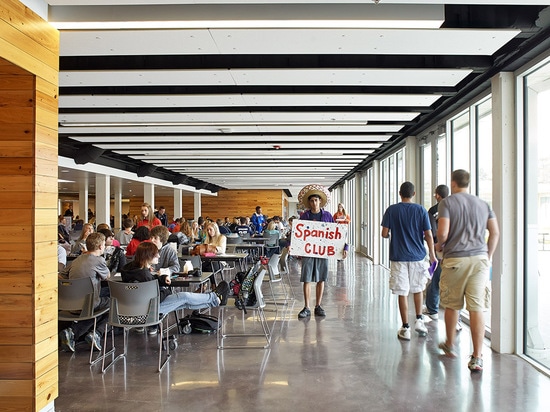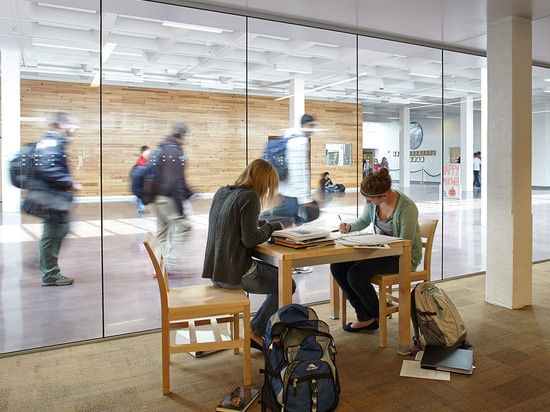
#PUBLIC ARCHITECTURE PROJECTS
Manhattan High School West Campus Expansion
Manhattan is a small city in northeast Kansas that is affectionately called "The Little Apple" and is home to Kansas State University. While the K-State campus is predominantly limestone, buildings off campus are a more varied lot, such as the existing orange-brick Manhattan High School. But this exterior cladding is only one way Gould Evans considered the existing building in its effort to expand and reorganize the school for its growing population.
What were the circumstances of receiving the commission for this project?
It was a traditional selection process consisting of a request for qualifications, interviews, and fee proposal. After the initial qualifications were submitted, Gould Evans was short listed to interview along with six other competing architecture firms. Based on the results of the first interview, Gould Evans and one other firm were invited to submit a fee proposal and return for a second interview presentation. A selection committee comprised of school board members, the superintendent, associate superintendent, and director of maintenance, made the final decision to award the project to Gould Evans. According to an article in the Manhattan Mercury newspaper posted May 7, 2009, the presenting team exhibited good communication skills and the presentation was tailor-made to the high school project. Board member Dave Colburn had this to say about the team: “By showing us their ideas they gave us an opportunity to evaluate the quality of their thinking."Please provide an overview of the project.
This large-scale expansion and remodel of Manhattan High School added approximately 79,000 square feet to the existing 250,000-square-foot school. Serving a student population of 1,200 students, the expanded campus facility accommodates future student enrollment up to 1,500 students. Included in the expansion are 14 new classrooms serving science, foreign language, general purpose, business, and fine arts, as well as expanded special education and library spaces.
What are the main ideas and inspirations influencing the design of the building?
Human inquiry was the primary driver in the reorganization of the high school that had survived multiple additions to accommodate its growing population. User focused research pointed to two primary concerns: a lack of organization and consequently a lack of dynamic community space. To clarity the building diagram and re-energize the student commons, a new core was defined by the reorganization of commons, cafeteria, and media center “bookended” between two large light filled and rejuvenated courtyards.
Were there any significant challenges that arose during the project? If so, how did you respond to them?
The challenges were two-fold:
To provide a unified design to a high school building that had multiple additions over the years all the while preserving and celebrating the personality and character of the administration, faculty, students, and community: The new and remodeled spaces provide clarity in way finding and circulation throughout the building, optimize program spaces to increase efficiency, enhance security, and provide ample spaces for social interaction and study.
To provide a design solution that reduces energy and environmental impact: This project met the 2030 Challenge… (>60% reduction in energy use over comparable building types in this region); bringing responsible new life to an old soul. It also makes use of materials that are either recycled or require little-to-no maintenance. The interior wood cladding is reclaimed lumber and flooring is polished concrete.
How does the building relate to contemporary architectural trends, be it sustainability, technology, etc.?
Rather than being driven by trends, we drew from our user research to determine with architectural ideas to integrate and how to integrate them. We wanted to make sure that design decisions were a direct response to their needs and wishes. Some examples of this are described below.Innovation:
Supporting the goal of way finding, a new visual “language” was overlaid upon the project at a multitude of scales. In some cases this language is literal, as found in the Braille texture calling out “Library,” or graphic as is found in the long runs of lockers, and in other cases it is conceptual, as is found in both the dappled light both natural and artificial filtered through the exterior scrim and transitioning into the interior fixtures and textures.
Sustainability:
Design expected to meet the Architecture 2030 Challenge for energy efficiency.
High albedo roofing reduces effects of solar heat islands
Reduced light pollution on site
Water use reduction via low-flow plumbing fixtures
Native, water efficient landscaping
Fundamental commissioning
Reduced energy consumption via optimized high efficiency HVAC system
High performance rain screen building envelope for increased thermal comfort
Refrigerant management (zero use of CFCs)
Reuse of an existing building
Recycled content materials
Regional materials
Increased Indoor Air Quality (IAQ) by removing hazardous indoor materials
Low emitting materials
All new, high efficiency lighting throughout
Day lighting control systems on interior lighting (daylight harvesting)
Daylight and views from majority of occupied interior spaces
Enhanced acoustic performance in classrooms
Lighting:
Fixtures were selected for aesthetics as well as energy consumption. Building-wide fixture replacement was a priority to increase energy efficiency. Where appropriate, day lighting controls turn lighting off when it’s a sunny day. Light layouts in the common areas also reinforce the design language. Fixture layout relates to openings in the exterior envelope so both natural and artificial light are handled in a similar manner in the public spaces.
Detail of Finishes:
Detailing of finishes is kept simple. This is a high school with a student population of about 1,200. As such, materials were selected for durability, longevity, and ease of maintenance. Where possible “self-finishing” materials were selected. Throughout the project one finds exposed concrete, wood, and glass. Color is overlaid in select areas as a visual cue to the organization of the building.
How would you describe the architecture of Kansas and how does the building relate to it?
Straight-forward forms and functional spaces are the foundations of vernacular Kansas buildings. In this project we combined simple forms with durable exterior materials and took advantage of natural light to illuminate interior spaces – all of which are tried-and-true methods of building on the prairie. It is a modern translation and, we admit, aesthetic, but the principals of the design are inspired by the same thinking that has gone into so many Kansas buildings over time. And on a deeper level, the colors of the facade panels compliment the range of color combinations found in the brick masonry of the existing building, which is a local fired material.





